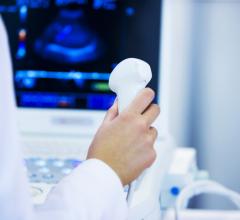
Greg Freiherr has reported on developments in radiology since 1983. He runs the consulting service, The Freiherr Group.
BLOG: How Clinical Versatility Helps Small Town and Rural Patients

Surgical ultrasound probes extend the capability of Hitachi’s Arietta 70 system. Each probe can be sterilized to allow safe scanning inside the human body. Picture courtesy of Hitachi Healthcare Americas
The clinical needs of those who live in rural America and small communities are both simple and complex. A physician may have to explain a patient’s back pain; uncover heart disease; or perform advanced surgery. Ultrasound can help do all three.
CentraState Medical Center, a community hospital in Freehold, N.J., leverages ultrasound for robotic surgery. The modality is described by CentraState’s robotic-surgery coordinator Lori Chavez, R.N., as “wonderful … I have seen it save the day.” If not for ultrasound, said Chavez who works with surgeons in the CentraState operating room, it would be difficult for surgeons to distinguish between cancerous and healthy tissue.
The ultrasound unit there is currently dedicated to robotic surgery, but that could change. Its use to support interventional radiology, she said, is being “looked at.” With dozens of compatible probes, the Arietta 70 can be used to conduct fundamental as well as advanced exams, said Tom Oko, executive director of marketing for ultrasound and surgery at Hitachi Healthcare Americas, which provides the ultrasound system.
Providing an Edge
Even as it is currently applied at CentraState Medical Center, the Arietta 70 gives the community hospital an advantage over nearby competitors. Some have turned to robotic surgery, according to Chavez, but none — to her knowledge — has used ultrasound the way CentraState has for the last several years. The surgery console there presents ultrasound images and an optical view of the operating field side-by-side.
Using the gripper at the end of the robot arm, the probe can be maneuvered around a patient’s kidney, for example, to identify the location and extent of the tumor. (CentraState first applied the Hitachi ultrasound system for this purpose — to assist in doing partial nephrectomies, Chavez noted.) Locating the margins between tumor and healthy tissue allows complete removal of the cancer, while protecting healthy tissue from excision.
Supporting Different Surgeries
Hitachi offers a wide range of surgical probes — ones not only for robotic kidney but open or minimally invasive surgeries of the liver or brain, for example. “Hitachi has many very specialized probes based on the shape of the (surgical) access point,” said Oko. One of these is designed for “burr-hole” neurosurgery, in which the probe is small enough to fit into a hole drilled in the patient’s skull.
All Hitachi surgical probes can be sterilized, which means they can be safely placed directly on tissue inside the human body, he said. The potential to use high-end ultrasound for shared services adds another dimension to the Arietta 70.
Ruralites or those living in small American communities might have to drive hours to visit a big urban medical facility, if nearby centers do not offer advanced capabilities. More is at stake than simply convenience. “Not everybody can get to those facilities,” Oko said.
And being clinically versatile can be essential to the survival of rural facilities, which must keep revenues up and costs down, noted John Walsh, marketing manager surgery ultrasound at Hitachi Healthcare Americas. Rural and community medical centers have to get the biggest bang possible from their investments in equipment.
“Sometimes procedures are pretty advanced but infrequently done. Coupled with that (these facilities) may have a limited budget,” Walsh said. “So they have to be assured that the equipment they buy can do those advanced procedures and they can do other (routine) things as well.”
Where X-ray Fits
Clinical versatility may require X-ray as well as ultrasound. Physicians at a rural facility may, for example, need to visualize a broken bone in one patient and perform X-ray fluoroscopy on another. Agfa HealthCare designed its DR 800 to handle both possibilities — even under challenging circumstances.
The system’s 180-degree tilting table allows wheelchair foot-on-table imaging, for example, as it supports a wide range of fluoroscopic imaging procedures, including shunt angiography to intravenous pyelography. Agfa’s MUSICA digital image processing, which is embedded in the system, allows digital X-ray processing and radiation dose optimization.
An urban center might use the DR800 to handle patients who otherwise can’t be scheduled on a dedicated radiography or fluoroscopy device. But a rural or community medical center might depend entirely on the DR800 to do both radiography and fluoroscopy.
Doing Basic and Advanced Apps
In a shared service configuration, applications of the Arietta 70 may range from general radiology or OB/GYN exams to a vascular or cardiology study — or to support surgery. This kind of clinical flexibility can make the difference between success and failure for rural and small community providers.
“They really need to get the most out of their investments as possible,” said Hitachi executive Walsh. “So the ultrasound systems need to do a lot relative to the investment.”
Greg Freiherr is a contributing editor to Imaging Technology News. Over the past three decades, he has served as business and technology editor for publications in medical imaging, as well as consulted for vendors, professional organizations, academia, and financial institutions.
Editor’s Note: This blog is the third in a series on Rural Healthcare in America. The first blog, Rural Imaging Requires Affordable And Versatile Equipment, can be found here. The second blog, Clinical Demands in Rural America Call for Advanced Imaging, can be found here. The next in this four-part series will look at how advanced diagnostic imaging can boost rural health.
Related content:
Rural Imaging Requires Affordable And Versatile Equipment


 April 24, 2024
April 24, 2024 








